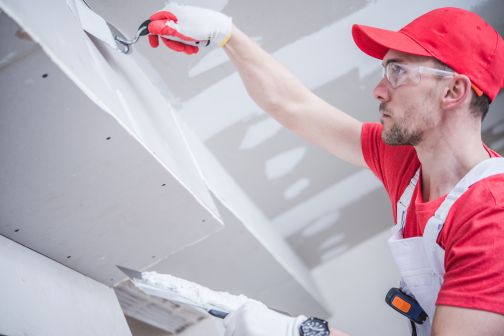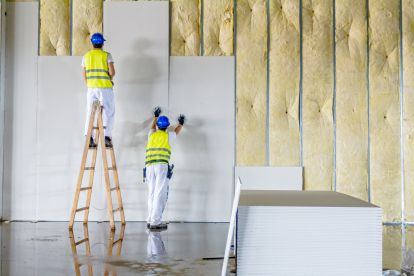Can drywall be waterproofed?
It is possible to protect drywall from water damage by applying water-resistant paints and veneers to it. There may be certain types of drywall that will work better in damp environments than others. But there is no way to completely protect drywall from water damage. There is no such thing as “fully water resistant” drywall.
Use a primer to seal the edges of drywall before you apply any other kind of protective material. It is possible to find waterproofing primers that are either oil- or latex- based and are sold by many paint manufacturers. These specific products work by preventing the growth of mold and mildew on the surfaces to which they are affixed.
Do I need to waterproof drywall?
It’s much easier to put up boards that will hold up against rain than to use drywall to reinforce shower walls. Installing drywall in your shower means that it must be water-proof drywall. Even despite the fact that you can safely use water-resistant drywall, you should still put down a top coat of something that is impermeable to water in order to prevent it from destroying your shower walls.
It’s important to keep following these tips so that your shower walls last for a long time. When you use the wrong materials, it can cause mold infestation in your home and ruin the shower tile that you put in it.
How do you waterproof drywall in a shower?
For a shower without drywall, put down some pressed cement board and use re-sealed rubber like RedGard to seal the walls. Tile with thinset, grout and caulk to keep it waterproof. Cement backer board and a waterproofing membrane are also needed for shower walls.
Using a waterproofing solution that’s applied by rolling out a large sheet of plywood, you can help keep drywall from drying out too fast by preventing water from entering the drywall. Water repellant primers are available as both an oil & a latex lpg. They protect drywall from water stains. It’s designed to prevent mold and mildew from forming on drywall. Roll membranes help dry drywall by creating a barrier that prevents water from getting inside the drywall and causing the drywall to become soaked. Some drywall products make drywall more waterproof. They all work to help it be waterproof. But it is not waterproof.

What is waterproof drywall called?
Greenboard was originally a waterproof drywall board that was developed in the 1960s. This is a product that makes gypsum board more difficult to damage, and it’s made from a very thick layer of gypsum that’s protected by a wax that makes it very resistant to water. It uses the gypsum that you find in drywall, but has a thick layer of paper under it that is backed with a protective wax to make it more water-resistant.
Greenboard gypsum board is used to cover the inside of showers and other rooms that are commonly used in homes that are outdoors. It is the sort of product that a basement or other area of a home that is often humid and damp will benefit from. Greenboard are not waterproof, but they hold up better than the gypsum board that covers most of the walls in homes across the United States.
Can you apply RedGard on drywall?
We have used many different drywall sealants that are good to use, but we have always used Redgard. RedGard generates a drywall waterproof barrier.
It helps to seal and protect drywall. It also prevents cracks in stone and ceramic tile. It will stick to nearly anything, but drywall is one of those places that does not get a lot of the necessary support.
Most people only require a sealer for their bathroom drywall and the backer boards for bathroom tiles, as these are usually drywall tiles. If the tile shower is to be installed in your bathroom then you should consider using a product like Redgard to keep your drywall dry.
Is there a waterproof drywall compound?
M2Tech®90 is designed to provide a durable and resistant setting for metal that is protected against water and mold. It will prevent moisture and mold growth and is formulated to give the final look to any M2Tech moisture and mold resisting system.
This setting compound is an easy-to-use, sanding powder that allows you to pre-fill joints, embed joint tape and hide fasteners and other accessories. It can also be used for interior repairs. It is a lightweight setting compound that can be mixed with other joint sealants, such as drywall sealants, to give a non-toxic finish to drywall. It is also very useful for repairing and securing damaged drywall. It will set in about 90 minutes. Compounds that are ready to be mixed in ready-made joints are used for finishing.
As these compounds harden, they create heat. To avoid burns, keep the substance ahead from exposed areas during the solidification process. After it has begun to set, do not implement or re-mix it. Compounds are safe if used on a dry, well-maintained surface. Applications must be of a higher grade.
Can drywall be waterproofed?
When you’re using interior walls, it won’t take long for mold, mildew, and fungus to begin the process of wrecking the drywall and lumber framing once the drywall becomes wet. Every ceramic tile shower requires a sturdy backer board that is water resistant. The Durock Ultralight Foam Backer Board is something we advise.
The best protection for your floors and walls against moisture and mold is cement board. Consider a cement board with the qualities listed below:
You can pass the industry’s mold tests with a perfect score thanks to moldblock technology.
Make sure it doesn’t contain gypsum, which can crumble when exposed to moisture continuously, or paper facing, which both serve as food sources for mold.
Can you use regular drywall in a tiled shower?
For a tile shower, drywall is not a suitable backing material. Even drywall that is moisture-resistant (often colored green or blue) is not strong enough to withstand exposure to water. Your tile will sag, crack, or fall out as the drywall ages due to moisture damage.
In places like kitchens, all over fireplaces, or other places where the wall is not in direct presence of moisture, you can tile over drywall. To ensure that your tilework endures the test of time for showers, special precautions must be taken.
Before tiling, it is crucial to moisture-proof your shower. This means that you must replace any existing drywall with a suitable backer board and seal and safeguard that backing items with waterproof mutual sealing products.
Is green drywall good for shower walls?
Drywall with a paper face that has been handled with a gloopy coating and substances that fend off moisture and mildew is known as “green board” drywall. While it works well for completing walls in humid environments, it should be avoided in extremely moist areas like shower and tub surrounds.
The term “greenboard,” especially among trade professionals, refers to a special kind of drywall used for walls in damp but not wet areas of a building. With the exception of the waxy coating that protects the paper facing from mold and water, it is exactly like regular drywall.


